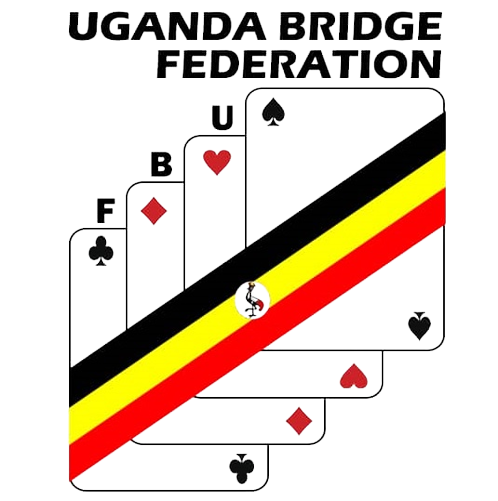








About Bridge
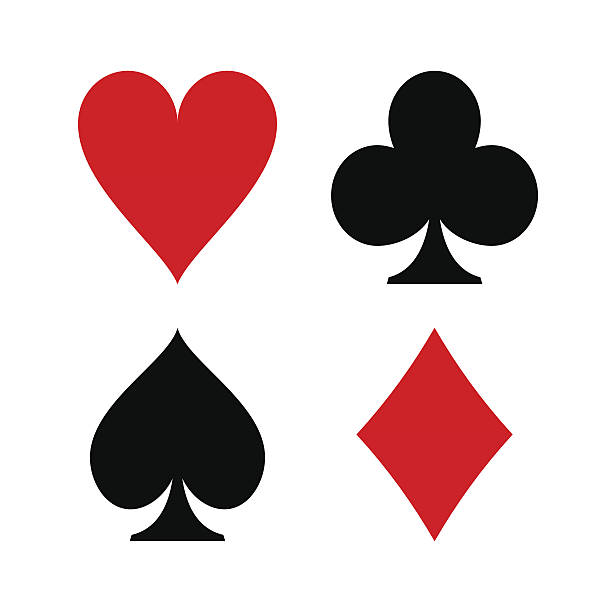
Bridge is the ultimate trick-taking card game, easily the greatest source of enjoyment that four people can have with a pack of cards.
It is enjoyed by tens of millions of people throughout the world – more so than any other card game. In social circles it is considered the card game. Whether you play casually among friends or seriously in clubs and tournaments, you will find it to be fascinating, challenging and enjoyable.
UBF Headline news
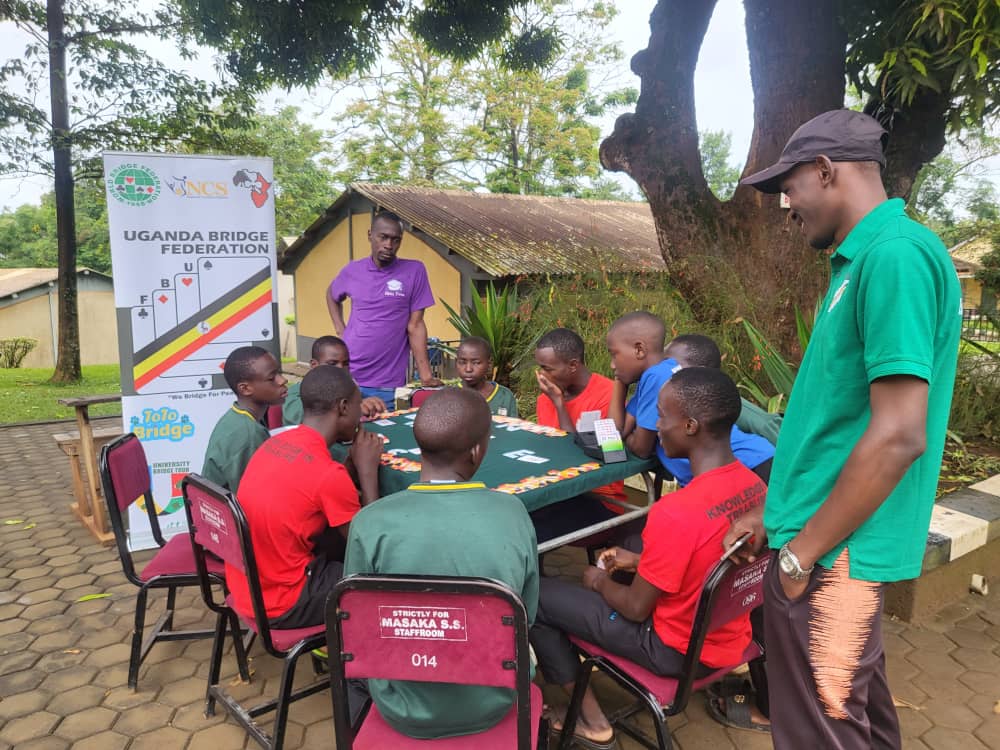
Uganda Bridge Federation Successfully Introduces Bridge at UMEA Solidarity Games 2024
The Uganda Bridge Federation (UBF) is pleased to announce the successful conclusion of its bridge demonstration at the UMEA Solidarity Games 2024, held at Masaka Secondary School from March 28th to April 1st, 2024.

The UMEA Solidarity Games, which began over three decades ago in 1989, have been instrumental in promoting unity among Muslim-founded schools, nurturing talents, advancing Islamic values, and preparing teams for national championships. The games, traditionally organized during the Easter holiday period, have become a cornerstone event in the Ugandan school sports calendar.
In a landmark collaboration, the UMEA Solidarity Games partnered with the Uganda Bridge Federation to introduce the intellectual card game of bridge to over 1500 students participating in the 2024 edition. Hajj Kiteezaala Twahil, Chairman of the UMEA Solidarity Games, expressed the association’s commitment to officially adding mind games, including bridge, to future editions of the games. He encouraged school representatives to embrace mind sports, especially bridge, to prepare for upcoming competitions.

Hajj Lwembawo Kyagulanyi Hussein, General Secretary of the UMEA Solidarity Games and Chairman of Mind Sports in the Uganda Secondary Schools Sports Association (USSSA), announced that bridge had been included in this year’s Secondary Schools National Mind Sports Championship scheduled for October at Wakisha Resource Centre.
Led by Egulwa Reagan, General Secretary of the Uganda Bridge Federation, the technical team conducted bridge demonstrations, teaching students the technicalities of bidding, play strategy, play memory, and bridge scoring over the four-day event. Students from different schools formed bridge partnerships and actively participated in the demonstrations.
Wamanya Linus, President of the Uganda Bridge Federation, expressed gratitude for the opportunity to showcase bridge at the UMEA Solidarity Games. He emphasized bridge’s role in improving students’ mathematics, decision-making skills, and critical thinking, underscoring its importance in educational institutions.

The Uganda Bridge Federation looks forward to further collaboration with educational institutions and sports associations to promote bridge and enhance intellectual development among students across Uganda.
For media inquiries or further information, please contact UBF.

In an exciting development for the world of mind sports, the Uganda Bridge Federation (UBF) has been granted a coveted slot in the upcoming UMEA Solidarity Games 2024. The event, set to be held at Masaka Secondary School from March 28th to April 1st, aims to promote solidarity and camaraderie among students from Muslim-based schools across Uganda. The inclusion of bridge in the games demonstrates the growing recognition and appreciation for the intellectual card game in the country.
The Uganda Bridge Federation, known for its relentless efforts to promote, develop, and protect the game of bridge, sees this opportunity as a significant milestone. Bridge, a game known for its strategic depth and intellectual challenges, is gaining traction in Uganda, particularly among students and young professionals. The federation believes that introducing bridge to platforms like the UMEA Solidarity Games will further popularize the game and encourage more participation among the youth.
“We are thrilled to have the opportunity to showcase bridge at the UMEA Solidarity Games,” said the Technical Director, Musasizi John. He added that”Bridge is not just a game; it’s a mental sport that fosters critical thinking, problem-solving, and teamwork. By participating in events like the UMEA Games, we hope to inspire more students to take up bridge and experience the thrill of competitive play.”
The UBF has been actively preparing for the event, organizing demonstration sessions and training workshops to familiarize students with the rules and strategies of bridge. Experienced players and coaches will be on hand to guide participants through the intricacies of the game and provide valuable insights into bridge tactics and techniques.
Following the UMEA Solidarity Games, bridge enthusiasts can look forward to another exciting event on the horizon. The Uganda Bridge Federation has announced that bridge will be featured in the National Secondary Schools Mind Sports Championship scheduled to take place in October 2024 at Wakisha Resource Centre. This national-level competition will bring together the best young bridge players from schools across Uganda to compete for top honors and showcase their skills on a larger stage.
As bridge continues to gain momentum in Uganda, events like the UMEA Solidarity Games and the National Secondary Schools Mind Sports Championship serve as important platforms for promoting the game and nurturing the next generation of bridge players. With the support of organizations like the Uganda Bridge Federation, bridge is well-positioned to thrive and flourish in the country for years to come.
For more information about the Uganda Bridge Federation and upcoming bridge events, please visit [UBF website or contact information].
BRIDGE FOR PEACE

- Why Play Bridge?
Learn to Play Bridge and Solve Puzzles
Researchers have found some very good reasons to play bridge:
Those who play more frequently score higher on cognitive tests.
♣♦♥♠
Bridge games offer intellectual and social stimulation on a routine basis.
♣♦♥♠
An area in the brain used in playing bridge stimulates the immune system. Researchers suggest that is because players must use memory, visualization and sequencing.
♣♦♥♠
Any activity from which you derive pleasure prevents the onset of classic depression. Players are less likely to be depressed; hence, they sleep better, tend to exercise more and have a better life in general.
♣♦♥♠
Multiple changes in lifestyle (e.g. cognitive training and social activity, two of bridge’s chief benefits) can improve memory and thinking in those at risk for cognitive decline.
♣♦♥♠
Playing bridge can help older people retain their mental sharpness.
♣♦♥♠
The frequency of playing games is associated with greater brain volume in several regions that are affected by Alzheimer’s disease.
♣♦♥♠
Successful people play bridge! Warren Buffet and Bill Gates are considered to be two of the smartest entrepreneurs in America. Both are also very accomplished bridge players.
Hall of Fame tennis star, Martina Navratilova writes that bridge “is more than just a card game. It’s a cerebral sport. Bridge teaches you logic, reasoning, quick thinking, patience, concentration and partnership skills.”
Summarized from an article in the AARP (American Association of Retired Persons) Bulletin:
“A Bridge to Brain Power” March 2015
Here’s another article in the AARP Bulletin, related to bridge:
Bridge Games Thrive Online Amid COVID19 Precautions June 25, 2020


- The WBF Women’s Online Autumn Festival will take place next week, from 6 – 12N ovember 2023. It is open to all women!
This is a fun, challenging and exciting event that has been enjoyed by women all over the world.
There will be 7 games per day: Pairs, Individual Robot and Individual Human, with times to suit every time zone.
The Festival is very popular with women players – yes, there is an excellent main prize for the winner of free entry to the next WBF Women’s Pairs Championship for her and a partner of her choice and WBF Online Master Points for the top 20 players, and there are also numerous other BBO prizes.
Taking Part
The games will be held on BBO. On the All Tournaments page, search for “Women” and once the tournaments are set up they will all appear there. The entry fee for each event is BB$1.
Further information:
- Women’s Online World Bridge Club
- Dates & Times (European Time (CET) is 1 hour ahead of GMT)
- Rules & Regulations
- Format
- More details
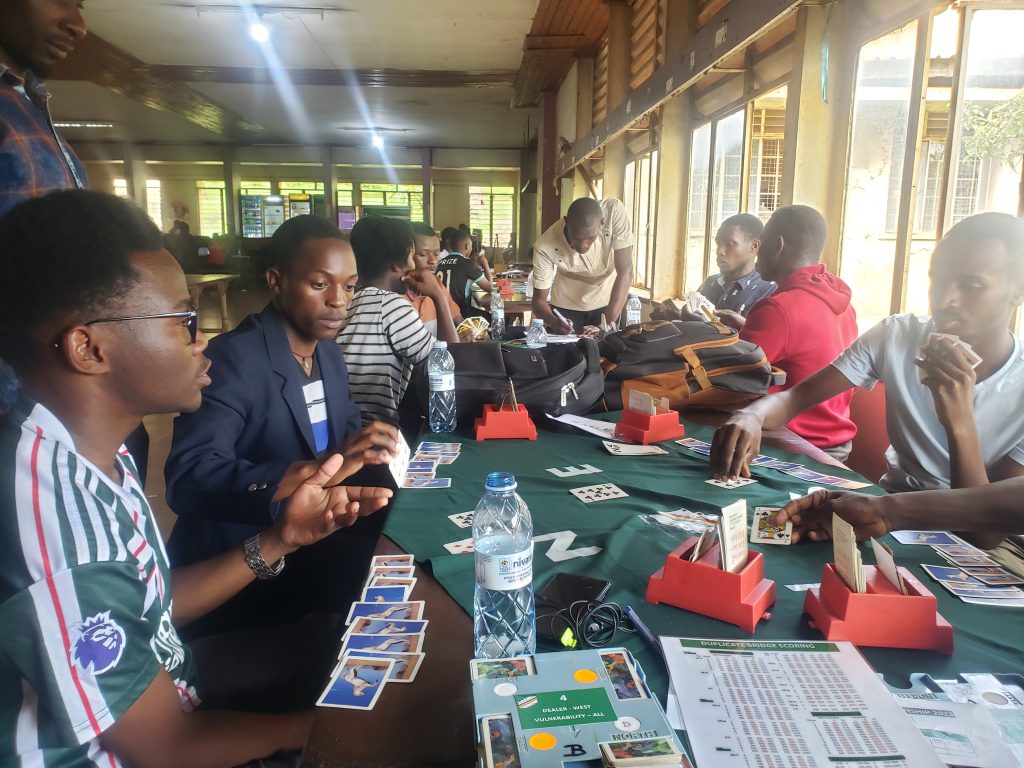
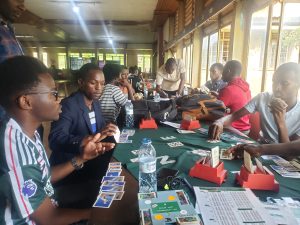
The Uganda Bridge Federation is a relatively new national Sports body . In it’s quest to introduce and spread the sport in Uganda, efforts have been directed to Universities first and currently they have created Makerere University Bridge Club, Kyambogo University Bridge Club, Nkumba University Bridge Club, YMCA Bridge Club, Uganda Christian University Bridge Club, IUIU Bridge Club and MUBS Bridge Club.
In preparation for the forthcoming AUUS Games scheduled for December at UCU, the Uganda Bridge Federation organized a University Bridge championship last weekend at Makerere University in Mary Stuart Hall and it brought together 6 pairs from Makerere University and Kyambogo university to compete in Duplicate Bridge pairs. In a 3 table movements system, pairs accumulated points over 16 boards and points were converted into the International Match Points ( IMPs) to determine the champions of the day.
🎴♠️♥️♦️♣️🎴
🥇Aruho Nabimanya & Berna Apio from Makerere University came first with 40 lMPs , followed by 🥈Michael Mwesigwa & Peterson Ntanzi from Kyambogo University with 35 IMPs and 🥉Emmanuel Wamala & Prize Muhwezi from Makerere University came third with 31 IMPs.
Egulwa Reagan the Competition director for the day states that “the players played with a lot of caution hence bidding low throughout the entire competition resulting into low scores per board. That explains why the IMPs recorded are low even when a complete cycle of 16 boards were played”.
Nevertheless, the entire organizing team is extremely humbled for the turn up of Kyambogo University and Makerere University Bridge players at this maiden championship.
As we prepare for the December AUUS Games, the Federation is continuing to engage and introduce Bridge to more universities with an aim to have a competitive bridge championship in December at Uganda Christian University.
Else where, the federation has activated it’s efforts to introduce and train Bridge in primary and secondary schools in preparation for the 2024 USSSA Mind Games Championship.
#WeBridgeForPeace
#UniversityBridgeChamprionship
#UgandaBridgeFederation-UBF


A new resource, already adopted by numerous Federations and teachers, has the potential to liberalize and enhance the development and learning of Bridge. The website www.bridge-training.com was created as a personal project by Jean-Pierre Desmoulins from France, an AI project engineer who also serves on the Executive Board of his Federation, responsible for development, and is a Bridge teacher and author.
Principle
The platform allows everyone, especially Bridge teachers, to make their deals playable with just a few clicks, free of charge and without registration. The initial version is available in English and French, but will soon be expanded to include other languages and additional features.
How it works in 3 steps
- Enter or upload a prepared deal (PBN or DUP file).
- Set your educational parameters (with or without bidding, minibridge or bridge, student’s position, predetermined cardplay at the beginning, comments, objectives, etc.).
- Generate a link that you can send to your students, allowing them to play the deal as instructed, against four robots, on any device (smartphone, tablet, or laptop).
Some new opportunities offered by this tool
- For a Federation: Create a webpage containing links to playable educational boards for their teachers. Sharing these links enables newcomers to practice and enjoy Bridge between sessions, accelerating their integration into club tournaments.
- For a Federation or a club: Create a paper flyer with a QR code linked to a simple board without bidding, to entice non-Bridge players to try the game (see example in Resources section).
- For a Federation, a club, or a teacher: Publish digital ads featuring a link that allows people to try Bridge immediately.
- For Bridge authors, journalists, or YouTubers: Include QR codes or links in their articles or video comments, directing readers to playable boards.
Interested? Here’s what you can do!
– This project has been managed with limited resources, aiming to remain free for all users. If you have skills in JavaScript (particularly) or PHP, and are willing to volunteer your time to help accelerate this project’s development, please contact Jean-Pierre at contact (at) bridge-training.com.
– Share this project with your Federation, your Club and your Bridge teacher friends!
– Become an active member of our community on Facebook at https://www.facebook.com/profile.php?id=100092414937746
Resources
– Presentation Video (automatically translated from French by AI) for the conference organized in early October by Realbridge and BAMSA: https://youtu.be/8COotm_15Zg?si=-zPUYPyfgXXfK2Ne
– Example of a deal generated from a file: https://bridge-training.com/player/?dds=NTEGfg7Y&lang=en
– Example of flyer using a QR-code to a discovery deal: https://1drv.ms/p/s!Ai3m6bTsv1R1kuZIuriIBl7iD9s7SA?e=wGYBA4
Uganda Bridge Federation
#WeBridgeForPeace

The University Bridge Championship 2023 is a pre Bridge tournament for University Bridge players held before the National University games which will take place later in December.

The competition organize Egulwa Reagan states that ” since the semester began at the various Universities, we have seen increase in number of Bridge players and for this particular championship we expect players from at least 4 Universities”.
Competition tables shall be determined by the number of registered players but 20 Boards and Matchpoints system is what to expect during the championship.
The University Bridge Championship is scheduled to take place on Saturday 28th October 2023 at Makerere University.

#UgandaBridgeFederation #BridgeForPeace #UniversityBridgeChampionship
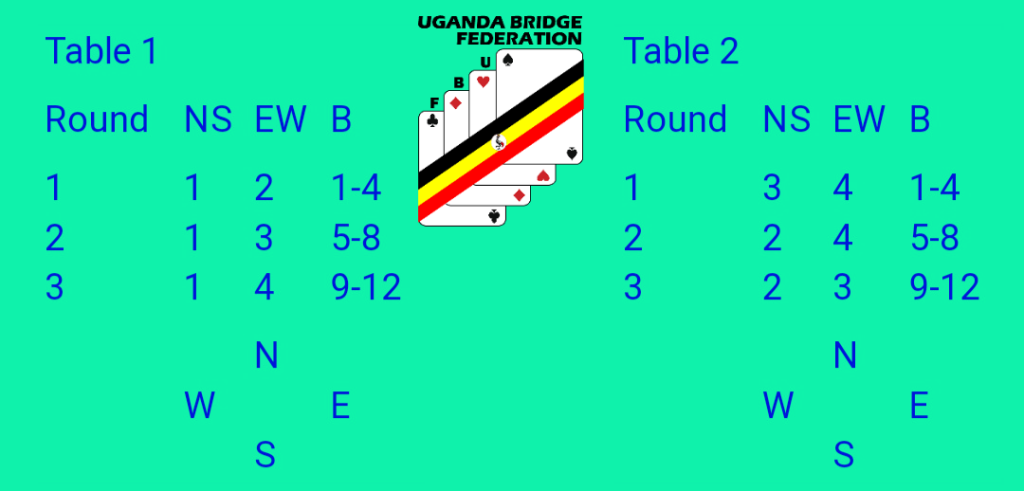
| ♣ ♦ ♥ ♠ |
Team Movement in Duplicate Bridge |
Download As Word Document |
Team competition
Singles competition
With only 8 players you may prefer to play a singles completion. In this format each player plays with a new partner at each movement. Scores are totaled individually for each player instead of for each team. However, each board must be replicated. For instance there must be 2 copies of board 1 that contain the exact same hands. This requires that someone (usually the director) must have set this up in advance. Since that person has already seen the hands, they should not participate in the game.
Let’s take a close look at some of these table sheets to make sure we understand how to use them. We’ll first look at the sheets for the 2 table team movement.
|
|
||||||||||||||||||||||||||||||||||||||||||||||||||||||||||||||||||||||||||||||||||||||||
In this movement the 4 teams will play 3 rounds of 4 hands each for a total of 12 hands. This is a reasonable number of hands for a typical session as this will usually take somewhere between 2 to 3 hours depending upon the amount of discussion of the new grandchild or your cousin’s wedding.
Notice that the teams are identified by numbers. The easiest way to accomplish this is to have your duplicate playing guests sit at the 2 tables opposite their partners and fill out sign in sheets which will assign each team a number and allow you to associate team numbers with the actual players when you have completed the scoring. These sheets should be on the tables when your players arrive so the team that sits in the N-S chairs (as defined by the compass points at the bottom of each sheet) at table 1 will know to sign in as team 1 and the E-W team will know that they are team 2. Similarly 3 and 4 will sign in as the N-S and E-W teams respectively at table 2.
Next note that the same boards (numbers indicated in the B column) are to be played during each round at the two tables. The way to handle this is to have one table play boards 1 and 2 while the other is playing 3 and 4. The boards can then be swapped when needed to complete the round.
When both tables have completed the play of boards 1-4, round 1 is completed. In this movement, team 1 will remain at table 1 while team 2 must move to table 2 since team 3 will be playing against team 1 at table 1. Similarly teams 2 and 4 will be playing each other at table 2. Round 2 is now played in the same fashion as round 1 but using boards 5-8. Since each team plays against all of the other teams, you will end of with one winning team, a second place team, etc. In the movements with more tables, each team will always sit in the same direction (N-S or E-W). Thus you will end up with a N-S winner as well as an E-W winner. The two table team movement is the most commonly used in the home environment as it can be difficult to find either the players or space for three tables of bridge.
Next we’ll look at two of the table sheets from the 3 table movement.
|
|
||||||||||||||||||||||||||||||||||||||||||||||||||||||||||||||||||||||||||||||||||||||||||||||||||||||||||||||||||||||||||||||||
Note that these sheets contain 2 additional columns that tell the players which table to move to after each round and where the boards are to go after each round. Just to make sure that we understand this, look at the last two columns of the first round for table 2. These columns indicate that, upon completion of the first round, the EW pair is to move to table 3 and that the boards (5-8) are to move to table 1.
You might find it worthwhile to print the movements and get them laminated so they will have more body and last longer.
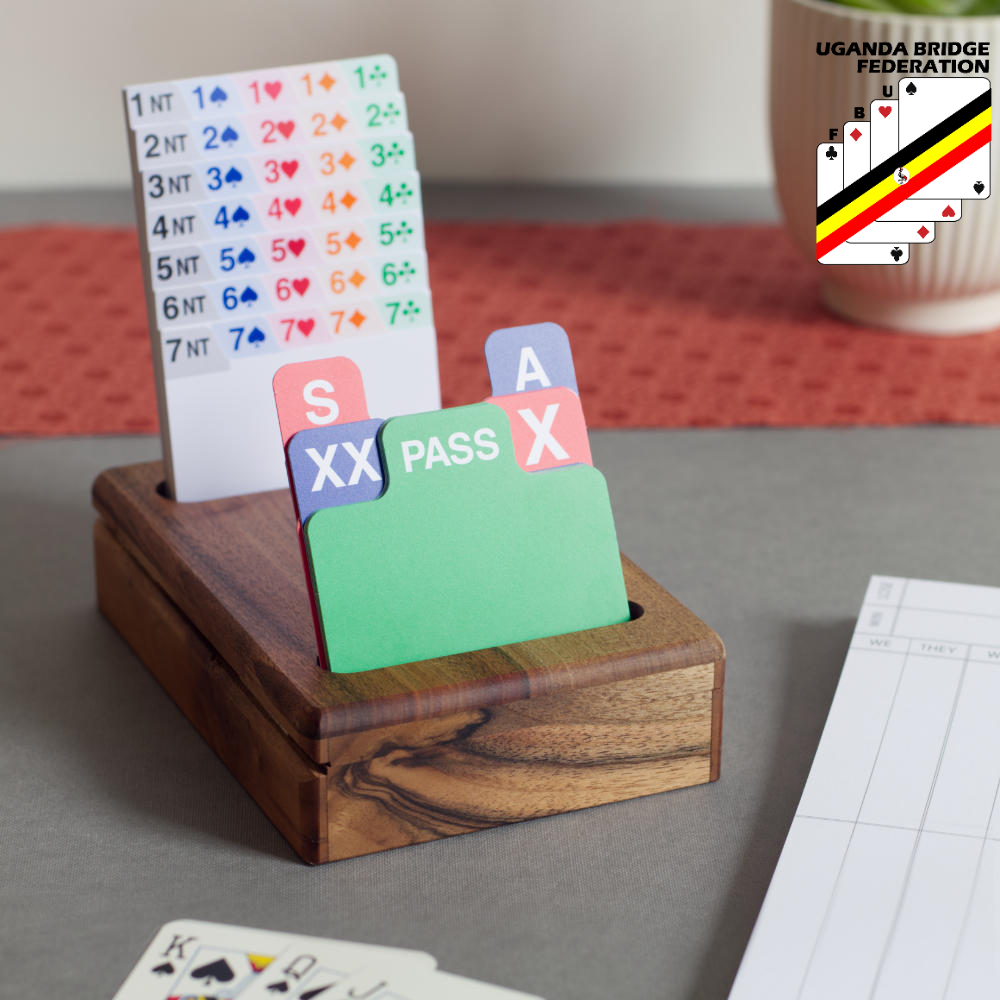
Bridge Teachers and Coaches Conference
RealBridge and BAMSA (Bridge: A MindSport for All) have arranged a short online conference on 7/8 October 2023 for bridge teachers, coaches and mentors.
The speakers are from around the world. Some material will be pre-recorded and subtitled. The entire conference will be recorded and made available subsequently.
The list of presenters is growing. As of today, 24 September 2023, these are confirmed.
Australia: Joan Butts, Paul Marston. Canada: Kathie Macnab. Czech Republic: Milan Macura. Denmark: Morten Bilde. France: Jean-Pierre Desmoulins. Germany: Ulrich Bongartz. Iceland: Matthías Imsland. Ireland: Dermot O’Brien. Italy: Benedetta Ragazzi. New Zealand/UK: Lyn Fry. Norway: Ane Haaland, Marianne Harding. Singapore: Gary Yee, Kelvin Ong. Sweden: Linnea Edlund. Tunisia: Meriem Daldoul Dorai. UK: Alan Shillitoe, Michael Rushworth, Sam Knox, Sam Punch. USA: Bronia Jenkins, David Loeb, Deborah Drysdale, Allison Evans, Patty Tucker, Rob Barrington, Robert Todd, Michael Berkowitz, Tracey Bauer. USA/Canada: Gavin Wolpert.
What is it all about?
The last 5 years have seen a decline in newcomers to the game, and also a drop in participation by existing players. There are a number of reasons for this.
But the last few years have also shown that there are many new opportunities. Communication is easier, faster, and more affordable. Engagement channels such as Facebook, Zoom and Twitch are readily available and better understood. Practitioners are more open to hearing ideas from other people. There is more understanding of, and openness to, collaboration and cooperation.
Topics
- Information on new approaches to teaching
- Channels, ideas and tools to market the game and the services
- Benefits of providing or earning accreditation
- How teachers can become the best version of themselves through personal development
- Youth players: organizational considerations, successes, issues, attitudes of schools
- Best ways to teach children and youth: practices, techniques, interactions, differences from adult teaching
- Approaches to coaching: supporting and overseeing the entire development of a player (as distinct from instructional teaching)
The presentations will mainly be case studies.
What do we hope you will achieve by taking part in this event?
- Obtain insights into latest trends, to inspire you
- Recognize opportunities and pitfalls
- Exchange views on shared challenges
- Network and collaborate
- Meet people you have heard about
- Understanding what can be achieved within typical budgets and timescales
Out of scope
- Demonstrations of bridge-specific software
- Fundraising
Practicalities
Where and when?
Dates: 7 & 8 October 2023, depending on time zones. Each session is 3 hours.
| UTC | EDT
New York |
BST
UK |
CEST
Paris |
AEDT
Sydney |
NZDT
New Zealand |
|
| Session 1 | Sat 7 Oct 08:00 | Sat 7 Oct 9:00 am | Sat 7 Oct 10:00 | Sat 7 Oct 7:00 pm | Sat 7 Oct 9:00 pm | |
| Session 2 | Sat 7 Oct 20:30 | Sat 7 Oct 4:30 pm |
Sat 7 Oct 9:30 pm |
Sat 7 Oct 22:30 | Sun 8 Oct 7:30 am | Sun 8 Oct 9:30 am |
| Session 3 | Sun 8 Oct 13:00 | Sun 8 Oct 9:00 am | Sun 8 Oct 2:00 pm | Sun 8 Oct 15:00 | Mon 9 Oct 00:00 |
This conference is online, on Zoom. This is a free conference. Anyone can attend.
Live presentations will typically be 20 minutes long, with an additional 5 minutes for Q&A. Pre-recorded and subtitled presentations may be a little longer than that, and will be available for view in advance of the conference. The provisional plan is that there are 5 presentations per session. So, in total 15 live presentation over all three sessions, and a further 10+ pre-recorded presentations. Some of them will be translated to French, Italian and Spanish.
How to take part?
Please complete this form so that we can send you more information about the event, pre-conference material, and joining link. The information we collect from you is solely related to this conference.
What to do now?
As an NBO or teaching association: please announce this to your teacher community. Let the conference organizers know if you would like to propose speakers. Ask people if they want to be on the mailing list.
As a practitioner: publicize this to your colleagues, or the club you teach at. Ask people if they want to be on the mailing list.
As a prospective presenter: Please contact us, submitting a short abstract (we suggest about 100 words). We now have 15 live presenters allocated to all the slots. We very much welcome presenters who can pre-record their presentations so that we can add them to the conference website.
As an interested person (researcher, journalist): let us know if you would like to be involved in the organization of the conference. Are you willing to help with writing a press release, previewing presentations, or other assistance?
To contact the event organizers: please email events@realbridge.online
Where to get more information?
Please continue to visit the conference website, here. We will be adding material to the site as the conference date approaches.
The conference is organized by RealBridge and BAMSA. We are grateful for the publicity provided by the NBOs and Zonal organisations.
#UgandaBridgeFederation
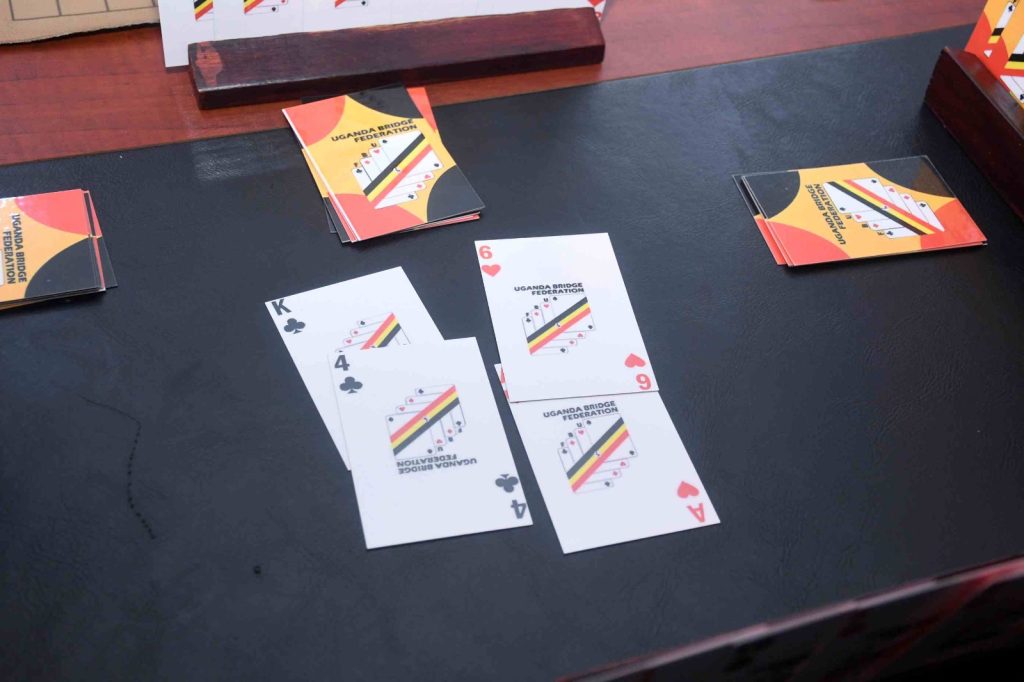
Bridge dictionary
Find the definition of bridge expressions and technical terms.
Bridge dictionary
All | A | B | C | D | E | F | G | H | I | J | K | L | M | N | O | P | Q | R | S | T | U | V | W | X | Y | Z
- 5-card major
- To hold at least 5 cards in Hearts or 5 cards in Spades in your hand.
:
- Aggressive
- Active defence play used in emergency situations, like underplaying an opponent’s King in the hope of taking future tricks.
:
- Auto-forcing
- The player who makes such a bid commits to not passing over partner’s next bid if game has not been reached and neither opponent has overcalled.
:
- Balanced hand, Balanced hands
- A hand is said to be balanced when it includes at most one doubleton without a singleton or a void.
:
- Balanced, Balanced hand, Balanced hands
- A hand is said to be balanced when it includes at the most one doubleton without a singleton or a void.
:
- Balancing bid
- Bid made after two passes.
:
- Bare suit, bare
- Having only one card (singleton) in a suit. Can also be said of cards: “to have a bare King” means to have only the King in the suit.
:
- Baron
- Bidding convention consisting of naming your long suits in suit ranking order (Clubs, Diamonds, Hearts, Spades).
:
- Bath Coup
- Technique used by declarer consisting of ducking a King lead in a no-trump contract with a holding such as Ace and Jack to make leader play into his tenace again.
:
- Be out (of)
- To have no cards left in a suit.
:
- Better minor
- Bid made in the following conditions:
– 1st bid made at the table.
– In minor suits, i.e. Diamonds or Clubs.
– In the longest suit (in which you hold the highest number of cards) among the two minors.
If the minors are of equal length, you bid 1 Club with 3 cards in Clubs and 3 cards in Diamonds. Otherwise, you bid 1 Diamond.
:
- Bid
- Anglo-Saxon term.
:
- Blackwood
- Conventional bid of 4NT asking partner how many Aces he is holding. Classic response bids are: 5 Clubs = 0 or 3 Aces, 5 Diamonds = 1 or 4 Aces, 5 Hearts = 2 Aces.
:
- Blocking
- When a suit cannot be fully run between declarer and dummy because of card rank.
Example: dummy holds Ace and Queen. Declarer holds King, 3 and 2. You cannot directly take 3 tricks in that suit. The suit is said to be blocked.
:
- Bonus, Bonus points
- When you make a contract, in addition to the points you score for won tricks, you can also score bonus points. 50 points are awarded for a part-score, 300 or 500 points for a game, 800 or 1,250 points for a small slam, 1,300 or 2,000 points for a grand slam.
:
- Call, Calls, Bidding, Bids, Bidding sequence, Auction
- Process with the aim of determining the final contract using bids. Together, the bids of a deal are called the bidding sequence or auction.
:
- Card play
- Refers to the part of the game after the auction, when players play their 13 cards.
:
- Cash
- To play your master cards.
:
- Ceiling
- Maximum strength held by both players of a pair. It is calculated by adding your points and the maximum number of points that partner can possibly hold.
:
- Communication, Communications, Entry, Entries
- Cards allowing you to switch from one hand to another (within your pair).
:
- Contract
- Commitment by declarer to win a specific number of tricks indicated in the final bid at the end of the auction. The final contract for a given deal is determined after 3 Passes. Example: after 1NT – Pass – 3NT – Pass – Pass – Pass, the contract is 3NT and the opener of the 1NT bid becomes declarer.
:
- Control bid, Control
- Bid in a suit telling your partner that you won’t lose two immediate tricks in that suit.
:
- Control, Controls
- Guarding a suit through honours (when you hold the Ace or the King) or through shortness (when you hold a singleton or a void).
:
- Convention, Conventions
- Bid allowing you to give a precise meaning to it after agreement with partner. May also refer to a card-play convention in defence which has a meaning agreed with one’s partner.
:
- Convert (to)
- The action of passing over a take-out double in order to score a penalty when you have strong opposition in the trump suit.
:
- Cover
- To play a higher honour over the honour presented by an opponent, most of the time in order to establish one of your own honours or one of the honours you hope your partner holds.
:
- Cover card
- Master card placed opposite a loser.
:
- Cue-bid
- To cue-bid is to bid an opponent’s suit. The aim is often to look for a stopper in that suit in order to play in no-trump or to show a strong hand.
:
- Deal
- Distribution of the 52 cards of the card deck to form the four players’ hands. A deal also refers to related distribution, bidding and card play as a whole.
:
- Dealer
- Player dealing the cards.
:
- Declarer
- The player who was the first to bid the strain of the final contract played by his pair. He therefore plays both his cards and those of the dummy sitting across from him.
:
- Discarding, Discard, Discards
- The action of following with a card of another suit than the requested one when you have no cards left in that suit.
:
- Distribution points
- These are points added to high card points when a fit other than no-trump is known to be held between the two players in a pair. It is then considered that a void is worth 3 points, a singleton 2 points, a doubleton 1 point, the 9th trump 2 points and each trump from the 10th onwards is worth 1 point. Of course, if you have a fit with your partner but you only have 1 trump for example, it will be difficult for you to ruff and, as a result, taking distribution points for your short suits into account is not appropriate.
:
- Double, Take-out double, Doubles, Penalty double, Penalty
- A call over an opponent’s bid which increases the scoring value of the contract made or defeated. It takes a take-out or penalty meaning depending on the situation. A take-out double asks partner to bid one of the unnamed suits. A penalty double or punitive double asks partner to pass because you think you can defeat the opponents’ contract. The double bid is symbolised by a white cross on a red background.
:
- Doubleton
- “To hold a doubleton” means to have only two cards in that suit.
:
- Drive out
- Also “to draw out”. The action of continuing to play a suit so that opponent plays an honour, allowing you to establish yours.
:
- Drury
- Convention used by responder when he initially passes to make sure that his partner’s opening bid is not weak.
:
- Duck
- Also “to hold off”. Technique consisting of keeping hold of a control in order to break communications between the two players of the opposing pair.
:
- Dummy
- Declarer’s partner. “Dummy” also refers to the cards of declarer’s partner, which are laid on the table once the opening lead has been played.
:
- Entry
- When you play in defence, it is a card which will allow you to regain the lead later. A well-positioned King or an Ace are typical entries.
:
- Establish, Establishment
- Playing several rounds of a suit to draw out the opponents’ cards so that you can take length tricks in that suit, or playing an honour to draw out a higher honour before taking one or several tricks in the suit.
:
- Finesse
- Technique consisting of playing a suit hoping for a specific positioning of opponents’ cards, allowing you to take one or several extra tricks. This technique is never certain but can allow you to win a trick that you would never have won if you had not tried it.
:
- Fit, Have a fit
- Having at least eight cards of a suit between both hands of a pair. The two players are said to have a fit.
:
- Follow (suit)
- To play a card of the requested suit.
:
- Fourth-best, 4th-best
- Lead convention mainly used in a no-trump contract where the opening lead is the 4th card (from the top) in a suit with no sequence.
:
- Fourth-suit forcing, 4th-suit forcing
- When three different suits have been bid on the first three bids made by the same side, a bid in the fourth suit is artificial. It asks opener to give more details about his hand. Fourth-suit forcing requires at least 11 HCP.
:
- Game, Games
- To score a game at bridge, you need to take a certain number of tricks, depending on the suit in which the contract is played.
In notrump: from the 3 level (i.e. at least 9 tricks).
In a major suit: from the 4 level (i.e. at least 10 tricks).
In a minor suit: from the 5 level (i.e. at least 11 tricks).
:
- Hand, Hands
- The 13 cards initially dealt to a player.
:
- High-card points
- This method of hand evaluation dates from the pre-war period and was invented by the Englishman Milton Work. It allows a player to determine a certain number of points for his hand. 4 points for the Ace, 3 points for the King, 2 points for the Queen and 1 point for the Jack. There are 10 high card points per suit and therefore 40 points per deck.
:
- Hold off
- Also “to duck”. Technique consisting of keeping a control in order to break communications between the two players in the opposing pair.
:
- Honour, Honours
- There are 5 honours per suit: Ace, King, Queen, Jack and 10.
:
- Jacoby transfer
- Convention used after the 1NT or 2NT opening bid. This convention consists of bidding 2 Diamonds or 2 Hearts (3 Diamonds or 3 Hearts over 2NT) to show 5 cards in Hearts or Spades. In theory, opener corrects the Jacoby transfer. This convention allows responder to describe both weak, intermediate and strong hands.
:
- Kibitzer
- Spectator of a game.
:
- Lead
- First card played to a trick.
:
- Leader, Leading
- Once the contract has been chosen, this is the first person to play a card (always sitting to the left of declarer).
:
- Length
- Number of cards in a suit.
:
- Length points
- These are points added to high card points to refine hand evaluation in no-trump contracts. There is 1 additional point for a good 5-card suit and 2 for a good 6-card suit.
:
- Length, Lengths
- Refers to having a lot of cards in the same suit. If you “have length in Hearts”, it means that you have a lot of Heart cards in your hand.
:
- Level, Levels
- Number of tricks beyond 6 to make in a contract. A contract at the 1 level will be made if the pair playing it takes at least 7 tricks.
:
- Major
- Refers to the Heart and Spade suits.
:
- Master card, Master cards
- Card with which you are sure to win the trick. It is therefore the highest remaining card in the suit played.
:
- Minimum rebid
- Rebidding a suit at the minimum level means bidding the same suit twice at the lowest level.
:
- Minimum strength
- Minimum strength held by both players of a pair. It is calculated by adding your points and the minimum number of points that partner can possibly hold.
:
- Minor
- Refers to the Club and Diamond suits.
:
- Misfit, Have a misfit
- Having fewer than eight cards of the same suit between the two hands of a partnership. The two players are said to have a misfit.
:
- Namyats
- Convention consisting of changing the meaning of opening bids at the 4-level. 4C shows a 4H opening bid with maximum one loser in trumps. 4D shows a nice 4S opening bid. 4H and 4S show opening bids with a not-so-good suit.
:
- Neutral
- Refers to defence deemed to be risk-free.
:
- Opener
- The player making the first bid (other than Pass).
:
- Opening lead, Opening leads
- The first card played to the first trick, just after the end of the auction.
:
- Opponent
- Player on the opposing side; player in the pair you are playing against.
:
- Overtake
- To play a higher card than partner (usually an honour) so that he does not keep the lead.
:
- Pairs tournament, Pairs event
- This is a type of tournament in which the results of a pair are compared to all results of the pairs playing on the same side (North-South or East-West) at the table. MP (Matchpoint) ranking is used in such tournaments.
:
- Part-score, Part-scores
- All contracts inferior to game or slam, i.e. all contracts from 1C to 4D, except 3NT.
:
- Partner
- Player with whom you play against the other two players.
:
- Pre-empt
- Jump bid showing a long suit and few defensive tricks. As well as giving precise information to partner, it aims to prevent the opponents from finding their best contract.
:
- Preference bid
- Bid saying which suit you prefer when your partner has described two suits (a two-suiter) during the auction. It does not, however, mean that you have a fit.
:
- Redouble
- Declaration over an opponent’s double increasing the scoring value of contracts made or defeated. The redouble bid is symbolised by two white crosses on a blue background.
:
- Responder
- In an auction, it refers to opener’s partner.
:
- Roudi and Checkback Stayman
- Conventions used by responder when making his second bid after opener’s 1NT rebid, in order to describe his hand.
:
- Ruff, Ruffed, Overruff, Overruffed
- Consists of playing a trump when you have no cards left in the suit played. It allows you to win the trick, except if you are overruffed, i.e. another player plays a trump higher than yours.
:
- SEF
- Acronym standing for “Système d’enseignement français”, literally French teaching system.
:
- Sequence, Top of a sequence
- A sequence is a series of cards in the same suit. It differs depending on whether it is a no-trump or a suit contract.
– In a suit contract, a sequence is made up of two consecutive honours (10 and 9 are also considered a sequence).
– In a no-trump contract, you need three consecutive honours for a top-of-sequence lead but false sequences are also accepted. A 4-card sequence with one card missing is called a broken sequence.
:
- Side
- Two players forming a pair against two other players. Often called East-West side and North-South side.
:
- Signal, Signals, Signal for
- In some situations, to follow with a card which conventionally invites partner to play a specific suit, generally by following with a high card in that suit.
:
- Single-suiter
- Hand with at least a 6-card suit and without any other 4-card suit (6322, 6331, 7222, 7321, 7330, 8…).
:
- Singleton
- “To hold a singleton” means to only have one card in that suit.
:
- Slam, Slams
- Small slam: contract at the 6 level, i.e. 12 tricks.
Grand slam: contract at the 7 level, i.e. 13 tricks.
:
- Splinter
- Jump bid showing a shortage in the suit jumped into and a fit in the last suit bid by partner. Normally, you do not make a splinter bid in a suit in which you hold a bare Ace or King.
:
- Standard count, Odd-even
- A signalling system consisting of showing an even number of cards by first playing a card higher than the next one (6, then 2 with 6 and 2 or with Jack, 7, 6 and 2 e.g.) or showing an odd number of cards by first playing the lowest card (2, then 6 with 8, 6 and 2 or with Jack, 8, 7, 6 and 2). These signals only apply to cases in which you have no interest in playing a high card at the trick in progress.
:
- Stayman
- Convention used after the 1NT opening bid to ask opener if he holds a 4-card major.
:
- Stopper, Stop, Guard
- Also “guards”. Term used mostly in no-trump contracts. A card or card combination preventing opponents from taking all tricks in a suit on the opening lead.
:
- Suit, Suits
- The suits in a deck of cards are Spades, Hearts, Diamonds and Clubs. Therefore there are 13 cards per suit in a deck of 52 cards.
:
- Suit-preference signal
- Card showing partner which suit to return. It is mainly used when you give partner a ruff or when dummy has a singleton.
:
- Switch (to)
- When you play in defence and you gain the lead, it consists of not returning the suit led by partner.
:
- Teams-of-four match
- A type of tournament in which two teams of four players play one against one another. The North-South pair of table A is associated with the East-West pair of table B, whereas the deals are identical at both tables. The way score is calculated is different from a pairs tournament.
:
- Tenace
- To hold two out of three consecutive cards in a suit, the one missing being the middle one. Example: holding Ace and Queen without the King, or King and Jack without the Queen.
:
- Third-suit forcing, 3rd-suit forcing
- After opener has repeated his opening suit, the next suit up is artificial when this is a new one. It asks opener to give more details about his hand. Third-suit forcing requires at least 10 HCP.
:
- To Pass, Pass, No bid
- It means not bidding, doubling or redoubling when it is your turn during the auction and therefore “passing” with the “Pass” bid.
:
- Top of nothing
- [Mainly in France] Refers to a lead from a bad suit (without honours) when you play in a no-trump contract. With 2 or 3 cards, you lead the highest one. With 4 cards or more, you lead the second highest one.
:
- Trick points
- All points scored by declarer’s side to make the contract. They depend on the contract’s trump suit. Clubs or Diamonds: 20 points per trick taken above six. Hearts or Spades: 30 points per trick taken above six. No-trumps: 40 points for the first trick, then 30 points for the following tricks. Bonus points have to be added to these points.
:
- Trick, Tricks
- A trick is made up of 4 played cards, one from each player at the table. The tricks taken by a pair allow the result of the contract to be determined at the end of the deal.
:
- Tripleton
- “To hold a tripleton” means to have three cards in that suit.
:
- Trump
- In a suit contract, trumps are the thirteen cards of that suit. When you don’t hold any cards in the suit played, playing a trump (i.e. ruffing) allows you to win the trick.
:
- Two-suiter, Jump two-suiter, Strong two-suiter, Economical two-suiter, Two-suiters
- Two-suiter: distribution including at least one 5-card suit and one 4-card suit. Examples: 5422, 5431, 5521, 5530, 6421, 6430, etc.
Jump two-suiter: bid in a second suit which could be made at the lower level.
Strong two-suiter: bid in a second suit which forces partner to bid your first suit at the 3 level.
Economical two-suiter: bid in a second suit allowing partner to go back to the first one at the same level.
:
- Unbalanced hand, Unbalanced hands
- A hand is said to be unbalanced when it includes one singleton, one void or at least two doubletons.
:
- Unbalanced, Unbalanced hand, Unbalanced hands
- A hand is said to be unbalanced when it includes one singleton, one void or at least two doubletons.
:
- Unblocking
- Technique consisting in getting rid of the cards hindering communications.
:
- Void
- “To be void” or “to have a void” means having no cards in that suit.
:
- Vulnerability
- The way bonus points or penalty points for setting tricks are awarded. When you are vulnerable, setting-trick penalties are higher but game and slam bonuses are higher too. Historically, in rubber bridge, a rubber was made of two winning games. It was then said that the side having already scored one game was vulnerable, while the side having not scored a game was not vulnerable. Vulnerability affects game and slam bonuses as well as the value of the setting tricks, whether they are undoubled, doubled or redoubled. In tournaments, each deal is independent. To recreate the conditions of a rubber, both sides are given a shadow vulnerability on each deal.
:
- XYZ
- Convention used by responder to describe his hand when making his second bid, where the auction is still at the 1-level.
:
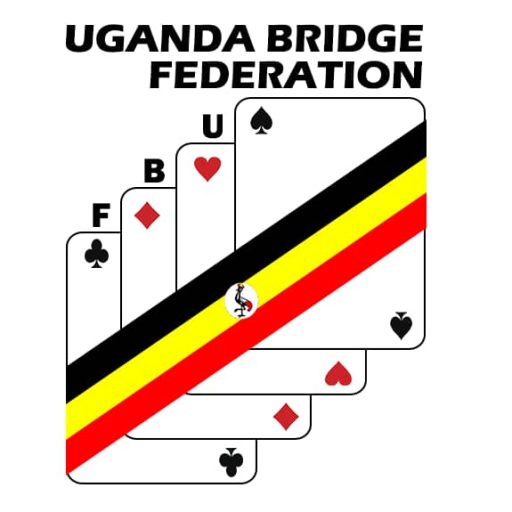
- Beginners’ Bridge Glossary
The Bidding
Auction — the entire round of bidding on a deal.
Bid — a number (1 through 7) followed by the name of a suit or notrump (1H, 3NT, 7C, etc.).
Call — any bid, pass, double or redouble.
Contract — the number of tricks the declaring side must take to earn a plus score. A bid becomes the final contract if it’s followed by three passes. (If the last bid is 3C, the bidder has contracted to make clubs trump and to take at least 9 — 6 for “book” plus the 3 bid — of the 13 possible tricks.)
Opening bid — the first bid that is not a pass. The player who makes this bid is called the “opener”.
Response — a bid made after partner has opened the bidding. The player who makes this bid is called the “responder”.
Overcall — a bid made after an opponent has opened the bidding. A suit overcall always promises at least 5 cards in the suit bid. A notrump overcall shows a balanced hand with 16-18 pts..
Rebid — any subsequent bid made by a player who has already opened, responded or overcalled in an auction.
Double — a special bid that can be made only over an opponent’s bid. A double describes your hand, but uses up no space in the auction. If a double is followed by three passes, it becomes a penalty double and increases the score of the final contract. A double usually has one of two meanings, depending on the previous auction:
Penalty double — Usually made at a high level, when the opponents have reached their final contract. This type of double is made when you expect the opponents’ contract to go down.
Takeout double — Usually made at your first turn to bid, and at a low level. This double shows strength and at least moderate length in all unbid suits. It asks partner to “take it out” of the auction by bidding his longest suit.
Redouble — similar to a double, but it can be made only over an opponent’s double. If a redouble is followed by three passes, it increases the score of the already doubled contract.
Cuebid — an artificial, strength-showing bid of an opponent’s suit (1H by your left-hand-opponent, 2H by you). The term “cuebid” is also used to describe a high-level bid that shows a specific ace.
Single (or simple) raise — to bid partner’s suit at the lowest level available (1S by partner, 2S by you). This shows a trump fit and minimum point-count.
Jump — to bid at a higher level than necessary (1D by partner, 2NT by you) to show strength.
Jump raise — to bid partner’s suit at a higher level than necessary (1H by partner, 3H by you). These jumps show trump support and extra strength.
Invitation — to make a bid (usually at a level of 2NT or higher) that asks partner to bid on to game level if he has more than minimum strength.
Jump-shift — to jump and change suits (1H-3D). This always shows a very powerful hand.
The Play
Book — the first six tricks taken by declarer. Only tricks in excess of book are counted for fulfilling the final contract. (To make a contract of 4S, you must take 10 tricks — 6 for book plus the 4 named in the bid).
Book also refers to the number of tricks the defenders must win before they can begin earning a score for defeating a contract. (If the opponents’ contract is 3D, book for defenders is 4 tricks — if they take a fifth trick, they defeat declarer’s contract and earn a plus score.)
Declarer — the player who first named the suit (or notrump) specified in the final contract.
Dummy — declarer’s partner. Dummy does not participate in the play. After the bidding is completed and the opening lead is made, dummy places his cards face-up on the table, sorted into suits, and they are played by declarer.
Defenders — opponents of declarer.
LHO and RHO — acronyms for Left-Hand Opponent and Right-Hand Opponent.
Trick — four cards, one contributed by each player in turn (clockwise around the table). The highest card of the suit led (or the highest trump) wins the trick. The player who wins the trick chooses the card to lead to the next trick. There are 13 tricks in each deal.
Lead — the first card played to a trick. Each of the other three players must follow (in clockwise order) by playing a card of that suit if they have one.
Opening lead — the card that starts the first trick of a deal, after the bidding is over. The opening leader is the player to the left of declarer.
Trump suit — the suit named in the final contract.
Notrump — a contract played without a trump suit. The highest card of the suit led wins the trick.
Trumping (or ruffing) — playing a trump on a non-trump-suit trick. A trump can be played only when the trump suit is led or when you cannot follow to the lead of another suit (you have no cards remaining in the suit led). A trump beats any card in any other suit. If a trick contains more than one trump, the highest trump wins the trick.
Discard (or pitch or sluff) — to play a non-trump card when you cannot follow to the suit led.
Finesse — an attempt to trap an opponent’s high card in a suit and thus avoid losing a trick to it. The most common finesses are made in suits where you have most of the high honors but are missing the king or queen. These holdings are called tenaces.
Revoke (or renege) — to fail to follow suit when you actually hold one or more cards in the suit led. This is a violation of bridge rules.
The Cards in Your Hand
Honors — Ace, King, Queen, Jack (and sometimes Ten).
High-card points — the total point-count of the honors (AKQJ) in your hand.
Quick tricks — high-card holdings that will usually win early tricks in the suit — aces, kings, and AK, KQ and AQ combinations. AK combination = 2 quick tricks; Ace or KQ combination = 1 QT; King = 1/2 QT; AQ combination = 1.5 QTs. A good opening bid usually contains 2 1/2 quick tricks. Other high-card holdings (queens, jacks and QJ combinations) are often called “slow” tricks.
Playing tricks — the number of tricks that your hand will take through power (assuming equal breaks of the missing cards), if you buy the contract. The most common way to figure playing tricks is to estimate how many tricks your long suit(s) will take and add that number to your quick tricks in other suits. For example, ♠AQJ1043 ♥AK43 ♦A ♣K3 is 9.5 playing tricks — 5 spades and 3 hearts (assuming each of the other three hands holds 3 hearts), plus the 1.5 quick tricks in the short suits.
Losing-Trick Count — another method of hand evaluation that figures potential losers (assuming equal breaks of the missing cards), if you buy the contract. In general, you count 1 loser for each missing ace, king and queen in any 3-card or longer suit; for each missing ace or king in a 2-card suit; for a missing ace in a 1-card suit. For example, the example hand above is a 3-loser hand (counting the spade king, heart queen and club ace as losers). ♠A543 ♥KQ43 ♦QJ2 ♣Q3 is a 7-loser hand (2 spades, 1 heart, 2 diamonds and 2 clubs).
Stoppers — protected honors you hold in a suit an opponent has bid. Examples are Kx, Qxx, Jxxx. This term refers to their ability to “stop” the opponents from running their suit if you declare a notrump contract.
Controls — holdings that will take the first or second trick if a suit is led. A first-round control is an ace (or a void, for trump contracts); a second-round control is a king or singleton.
Void — to have none of a suit in your hand.
Singleton — a one-card suit.
Doubleton — a two-card suit.
Balanced hand — having no void or singleton suits and (usually) no more than one doubleton. Balanced distributions of your 13 cards are 4-3-3-3 , 4-4-3-2 , 5-3-3-2 (sometimes 5-4-2-2).
Unbalanced (distributional) hand — any hand that doesn’t fit the description of a balanced hand. These include two-suiters (5-5-2-1 or 6-5-2-0, etc.) and other hands with voids, singletons and/or long suits (6+-cards).
Distribution points — a method of hand evaluation in which you also assign points to short suits: 1 pt. for a doubleton, 2 pts. for a singleton, 3 pts. for a void. Add these points to your high-card points to figure total point-count. Distribution points should be counted after you and partner have found a trump fit. In general, don’t add in distribution points when deciding on an opening bid.
Tenace — a broken honor combination in a suit (AQ, KJ, AJ, Q10, etc.). These holdings often allow you to trap the missing honors by taking a finesse.
The Scoring
Trick score — the points awarded for each trick (over book) taken by declarer if the contract is made.
- Minor-suit contracts (clubs and diamonds) score 20 pts. per trick.
- Major-suit contracts (hearts and spades) score 30 pts. per trick.
- Notrump contracts score 40 pts. for the first trick, 30 pts. for each subsequent trick.
Game — a contract whose trick score will add up to at least 100 pts. if declarer makes the bid number of tricks. To score a game on one deal (and receive the game scoring bonus), you must bid up to a level of :
- At least 3 in notrump (100 pts. — 40 for the first trick, 30 for each of the next two)
- At least 4 in hearts or spades (120 pts.)
- At least 5 in clubs or diamonds (100 pts.).
Slam — a contract of six or seven. These contracts award large scoring bonuses.
- Small slam — any contract of six, in a suit or notrump.
- Grand slam — any contract of seven, in a suit or notrump.
Partscore — any contract below game level. Trick scores from two or more part scores can be combined to reach 100 pts. and earn the game bonus.
Penalty — a score given to the defenders when declarer fails to make his contract (goes down).
Pass-out — a deal where all four players pass. At rubber bridge, no score is recorded, and the hand is redealt. At duplicate bridge, the hand is scored as 0 for each side, but not redealt.
Honors — a score (100 or 150 pts.) awarded when one player holds 4 or 5 of the top honors in the trump suit or all 4 aces in a notrump contract. These are only counted in rubber-bridge scoring.
Rubber — two games. The partnership that bids and makes the first two games (or whose part scores add up to two games) receives bonus points for winning the rubber.
Vulnerable — having bid and made one game in the current rubber.
Not vulnerable — having no game in the rubber.
Duplicate Bridge
ACBL — American Contract Bridge League, the national organization that sponsors and sanctions duplicate games at clubs and tournaments. ACBL awards masterpoints and keeps point records for members.
Masterpoints — point awards for winning or placing in a duplicate-bridge event sanctioned by ACBL.
Board — the metal or plastic tray that holds the pre-dealt cards. This term also refers to the whole deal itself (“What was our score on Board #4 ?” or “We played 26 boards against Joe’s team.”).
Bidding box — a small, tabletop box that holds pre-printed cards (one for each of the 35 possible bids, plus several Pass, DBL and RDBL cards) used for silent bidding. Bidding boxes are used by many clubs and almost all tournaments.
Matchpoints — a form of scoring used in pairs games. On each board, your score is compared to the scores of the pairs who held your same cards. You receive one matchpoint for every pair you beat and 1/2 matchpoint for every pair you tie. The pair with the most total matchpoints on all the boards in the session wins the game.
Top — the maximum number of matchpoints you can earn on a board. If a board is played eight times in a duplicate session, “top” is 7 because the best you can do is beat the other seven pairs who played it.
Bottom (or zero) — the opposite of a top.
Stratified pairs or teams — events that offer extra, separate masterpoint awards to novice and intermediate players. Players of all skill levels enter the same event, but each pair is classified into a stratum (A, B, C) based on their masterpoint holding. Point awards are given to the top pairs in each stratum.
IMPs (International Match Points) — a form of scoring usually used in team games. On each board, the difference between your score and your opponents’ score is converted to IMPs, which can be positive or negative. The team with the most total positive IMPs on all boards wins the match.
Swiss teams — an event for teams of four players. Each team plays short matches against several other teams and scores the results by IMPs. Masterpoints are awarded for each match won.
Knockout teams — a multi-session team event. In the first session, each team plays a long match against one other team. The loser is eliminated; the winner advances to play another winning team in the next session. Matches continue until there is one winner.

Bridge is a 4-player card game played in teams of 2 where bidding is essential for maximizing your score. A bid is when you state out loud to the rest of the players how many “tricks” (or hands) your team will win.[1] There is some strategy involved in bidding, but you can learn how to make successful bids by following some basic rules.
Making the Opening Bid
-
-
 1
1Count up your high-card points before you bid. Before you make your first bid in bridge, count up the points you have in your hand. Your high-card points include:[2]
- Ace: 4 points each
- King: 3 points each
- Queen: 2 points each
- Jack: 1 point each
-
 2
2Bid only if you have 13 or more high-card points. Once you have added up your total high-card points, you will know if you should bid or not. You should never open the bid unless you have 13 or more high-card points. If you have less than 13, then you should pass.[3]
- For example, if your hand includes 1 Ace, 1 King, 1 Queen, and 1 Jack as its only high-card points, then your total would be 10 and you should not bid. However, if you have 2 Aces, 1 King, 1 Queen, and 1 Jack, your total would be 14 and you should bid.
Advertisement -
 3
3Announce a no-trump bid if you have between 15 and 17 points. A no-trump bid means that you will take a hand without placing an Ace. If you have a balanced hand with 15 to 17 high-card points, then this is a high likelihood.[4]
- For example, if you have about the same number of cards in each suit, then you have a balanced hand.
- If you have a highly unequal distribution of card suits with 15 to 17 points, then this might not be a good strategy. For example, if you have twice the amount of clubs as hearts, and diamonds, then your hand is unbalanced and you should not risk a no-trump bid.
-
 4
4Open with a 2-suit bid if you have 22 points or more. You can make a 2-suit bid if you have a very high scoring hand. In this case, it is highly likely that you will be able to fulfill the bid with an equivalent number of tricks (hands where you have the highest ranking card).[5]
- For example, if you have 3 Aces, 2 Kings, 2 Queens, and 2 Jacks, your hand would contain 24 high-card points. This means that you should have no problem making a bid of 2 or more suits.
-
 5
5Choose your high-card suit to open. If you open the bid, then you will choose the card that starts the round. Make sure that you choose a card from your high-card suit, which are the cards that you have the most high-card points in.[6]
- For example, if you have 7 high-card points in spade cards, such as an Ace, Queen, and Jack of spades, then open by laying down a spade.
- The card you choose will also help you to signal to your partner which card is your strongest suit, so choose wisely.
-
Observing the Rotation Rules in Bidding
-
-
 1Allow the dealer to bid first. The dealer is always the first to bid in a round of bridge. Then, play can continue going clockwise from the dealer. If the dealer wishes to pass, then they can say “pass.”[7]
1Allow the dealer to bid first. The dealer is always the first to bid in a round of bridge. Then, play can continue going clockwise from the dealer. If the dealer wishes to pass, then they can say “pass.”[7] -
 2
2Make a bid higher than or equal to the previous player’s bid. You cannot bid lower than the previous player. Therefore, if the player before you has bid 1 heart, then you would at least have to match that bid with 1 spade, 1 club, or 1 diamond. (You cannot bid with the same suit as the previous player.) You may also bid higher, such as 2 spades, 2 clubs, or 2 diamonds, instead of 1 of these suits.[8]
- Remember that you can say “pass” if you do not want to bid.
-
 3
3Stop taking bids once 3 players in a row have said “pass.” Bidding continues until 3 consecutive players have passed on the chance to bid. The last bid that was made will become the “contract,” and that pair of players will need to complete the number of tricks they bid plus 6. At this point, the game begins and players can start playing tricks, or putting down cards.[9]
- The player who names the final contract suit first is called the “declarer” and their partner is the “dummy.” The person on the left side of the declarer will then make the opening lead. The dummy puts their cards facing up on the table so that the declarer can play with both their cards and their partner’s cards.
-
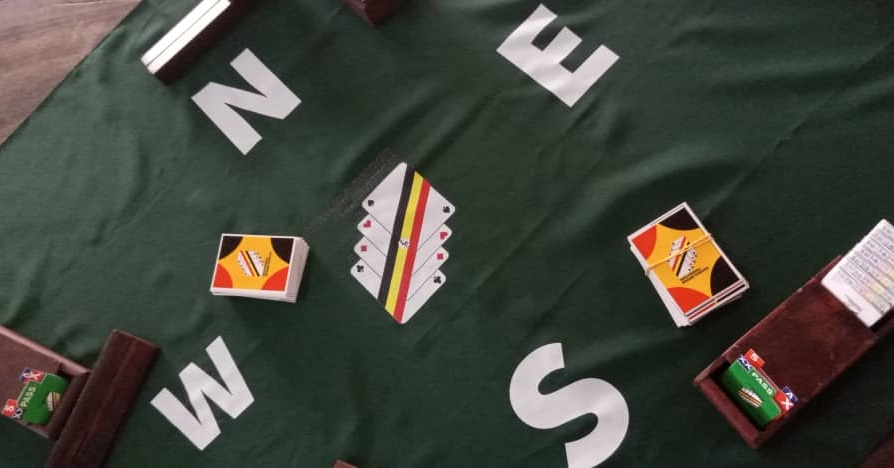
This tool allows you to count points at bridge according to the contract and tricks.
The points earned depend on the contract, the number of tricks taken and the vulnerability of the declarer’s side.
Then bonuses for overtricks, part-scores, games and slams apply.
Use this bridge calculator to count your points easily.
Contract
Tricks
-8-7-6-5-4-3-2-1=+1+2+3+4+5
90 points
How to keep score in bridge?
Play bridge
A bridge game starts once the bidding phase ends and a final contract is determined between the four players. The players use a deck of 52 cards. Each player holds 13 cards that are called the “hand“.
A bridge game consists of several units called “deals“. A deal consists of two phases: the “bidding phase” followed by the “play of the hand“.
A bid is a bet to take the specified number of tricks above six, in the specified strain. Two conditions must be met for a bid to prevail over another one: either the bid made is a bet to take more tricks, whatever the strain is, or it is a bet to take the same number of tricks but in a stronger strain.
Card order and value
Here is the card order for each suit: Ace – King – Queen – Jack – 10 – 9 – 8 – 7 – 6 – 5 – 4 – 3 – 2.
The suits are assigned value with clubs the lowest and notrump the highest: clubs, diamonds, hearts, spades, notrump. The trump suit is the suit named in the final bid, other than notrump. A card of the trump suit is a winner over any card of a plain suit, when you can’t or can no longer follow suit.
In bridge, you count tricks (up to 13), not points.

What is a trick?
The players play in turn and are obliged to play a card of the same suit as the one led. The highest card in the suit led wins the trick. If a player is out of the suit led, he can “discard” (i.e. play a card of another suit) or “ruff” (i.e. use a trump) if he wants to.
Each player plays a card in turn so the trick consists of four cards placed face up on the table. The highest card wins the trick and the winner of the trick plays first at the next one.
Understanding the notion of vulnerability
In rubber bridge, a side becomes “vulnerable” when it has already won one game and is thus subject to doubled penalties. When you are vulnerable, premiums and penalties are much higher. The other side is “non-vulnerable“.
In contract bridge, which is the modern variant of bridge, the vulnerability of each side varies from one deal to another based on the number of deals. Vulnerability aims at diversifying opposition situations and making the game more interesting.
The different combinations of vulnerability (love all, game all, unfavourable, favourable) are rotated. When you are vulnerable, you are said to be “red”. When you are not vulnerable, you are said to be “white”.
Trick points
These points are allocated for the tricks taken in a successful contract only. Overtricks are counted separately.
If declarer makes his contract, the number of tricks taken (over “book”, i.e. over trick 6) is counted and multiplied by the contract suit factor. Points for each trick required and taken are scored as follows: 20 points in clubs and diamonds, 30 points in hearts and spades, 40 points for trick 7 in notrump and 30 points per trick over trick 7.
These points are multiplied by two or quadrupled respectively if the contract has been doubled or redoubled.
Bonuses in bridge
There are 4 types of premiums in bridge: overtrick bonus, part-score bonus, game bonus and slam bonus.
Overtrick bonus
You get an overtrick bonus for taking tricks in excess of those required to fulfil the contract. Overtricks are also called “extra tricks“. They are not taken into account in the calculation of game and slam bonuses. They carry premium values if the contract has been doubled or redoubled.
Part-score bonus
You get a part-score bonus when the contract required is below the game level, i.e. a trick score of fewer than 100 points. A bonus of 50 points called “part-score bonus” is then automatically awarded.
Game bonus
A game bonus is awarded when the contract required has reached or exceeded 100 points, the contract being considered as a game here. Bonuses of 300 and 500 points respectively are given to non-vulnerable and vulnerable sides. The game bonus replaces the part-score bonus. These premiums can’t be cumulated.
Slam bonus
Slam bonuses are divided into two categories: small slam and grand slam. A small slam is a contract requiring declarer to make six-odd, or 12 tricks in all. A grand slam is a contract requiring declarer to win all 13 tricks (7-level).
Just as in the case of the game bonus, the slam bonus can vary according to the side’s vulnerability but not whether the contract has been doubled or redoubled. This bonus is added to the game bonus.
The bonus for a small slam is 500 points when not vulnerable and 750 when vulnerable.
The bonus for a grand slam is 1000 points when not vulnerable and 1500 when vulnerable.
Double and redouble principle
Here we are talking about a factor weighing heavily in point calculation. When the contract is “successful“, trick points won are multiplied by two or quadrupled respectively if the contract has been doubled or redoubled.
If the contract is not fulfilled, a double or a redouble increase the number of points scored by the defence, making penalties significantly greater for declarer.
Undertricks and overtricks
In a bridge game, if declarer is not able to take the number of tricks agreed, the contract “fails”. In that case, the penalty points are scored on the opponents’ side (the side that defeated the contract). Penalties depend on the number of missing tricks, declarer’s vulnerability but also whether the contract has been doubled or redoubled.
Some players use an easier and quicker way to calculate points. It is a scoring system that counts bridge points according to the contract and tricks.
This exhaustive table lists undertrick and overtrick values.
| Undertricks / Overtricks |
Non-vulnerable | Vulnerable | ||||
|---|---|---|---|---|---|---|
| Undoubled | Doubled | Redoubled | Undoubled | Doubled | Redoubled | |
| 1 undertrick | 50 | 100 | 200 | 100 | 200 | 400 |
| 2 undertricks | 100 | 300 | 600 | 200 | 500 | 1000 |
| 3 undertricks | 150 | 500 | 1000 | 300 | 800 | 1600 |
| Each extra undertrick over undertrick 3 |
50 | 300 | 600 | 100 | 300 | 600 |
| Overtricks | 20 or 30 | 100 | 200 | 20 or 30 | 200 | 400 |

Is bridge difficult?
Bridge game rules start out simple but get progressively more complicated. There are several things to consider, such as bridge bidding, scoring, other bridge game rules that might confound beginners or even intermediate players.
Our resources will help you understand not only the rules themselves but also the reasons behind some of the complexities.
What do you need to play bridge?
Once you have decided to learn bridge game, the bare minimum materials you need:
- 4 players
- A 52 cards deck
- A score pad
- Something with which to write
Advanced players, particularly playing duplicate bridge, will also need bidding boxes and “boards”, which are trays into which the cards are inserted.
Bridge rules
As we saw previously, bridge is a card game played with 4 players divided into 2 teams of 2 people each. The players sitting across from each other at the same table form partnerships as North‑South and East‑West.
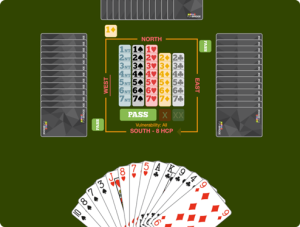
Bridge players position – west, east & North, South
But before getting to the heart of the matter, there is one thing you need to know and that makes bridge different than other card games: the lingo.
The two teams are also called “pairs”.
In a pair, whoever is playing the hand is the “declarer” because that person has declared the “trump suit” or has made the hand to be played without a trump suit, which is called “notrump”.
The “dummy”, which comes from the French word for silent, is the declarer’s partner and places the hand face-up on the table after the “bidding” is done and the “opening lead” is made by the player on declarer’s left.
The other two players are the defenders for that hand. These terms are just a few of the things you will learn during learning bridge.
If you want to know more about these bridge terms, please visit our bridge glossary.
(Or go to our how to play bridge tutorial in our app. When you use our tutorial, how to play bridge will become clearer and clearer as you progress.)
Bridge bidding
A bridge deal consists of two phases: bidding and card play. In this phase, players bid for the minimum number of tricks they think they can take to win the deal.
The dealer makes the first call. He is the “opener”. Then the auction proceeds clockwise. There may be several bidding rounds.
The bidding ends when three players in succession say Pass, meaning that they do not want to bid higher. The final bid becomes the “contract”.
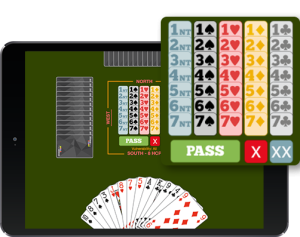
Duplicate bridge bids –
A bid in bridge consists of:
- A number from 1 to 7 called “level”.
- A suit (spades, hearts, diamonds or clubs) or “notrump” (NT).
The number refers to the total number of tricks (six plus the number indicated in the bid) one pair has contracted to make. The suit indicates the trump suit.
For instance, the North-South pair has bid 4H. It commits to making 10 tricks with hearts as trumps.
If a player thinks that the last bid made by one of his opponents is too optimistic, he can double it when it is his turn to speak. This double can be redoubled by an opponent.
The purpose of bidding is to relay information about the strengths and weaknesses of your hand to your partner. It will help you determine the easiest contract to make based on your respective hands. It is therefore important to know the meaning of each bid. This is referred to as “bidding systems and conventions”.
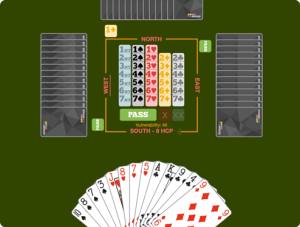
Take a look at the bid decoder now!
Bridge card play
Once the bidding is over, the play begins. Here the aim is to win tricks equal to or greater than the number bid (level).
The players
The “declarer“: the player of the pair who first mentions the suit or notrump that becomes the final contract.
The “dummy“: the declarer’s partner.
The “defence“: the opponent team.
Step 1: the opening lead
The player to the left of the declarer starts the play by making the “opening lead”.
He names the suit and the other players have to play a card in that suit if they have one.
Otherwise they can ruff with a card in the trump suit or discard any other card.
Step 2: the dummy lays out his cards
After the opening lead, the dummy places his 13 cards face-up on the table and his partner calls the cards during the play for both hands.
Step 3: winning tricks
Whoever has played the highest card in the suit wins the trick and leads any card in any suit desired to the next trick.
In a trump contract, if a player doesn’t have a card in the suit led, a trump can be played. In that case, he takes the trick unless a higher trump card is played by someone else.
Step 4: the end of the deal
At the end of the deal, if the declaring pair takes the number of tricks (or more) it committed to in the initial contract, it scores a certain number of points. But if it doesn’t make its contract, the other pair score points.
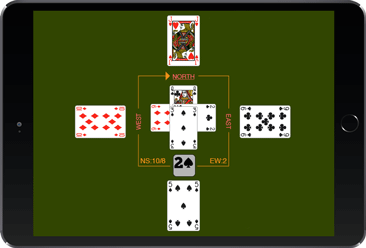
Number of points scored at the end of a bridge deal
Bridge game scoring
An online bridge scoring tool that helps you count points at the end of the bridge deal is available.
Bridge scoring calculator online tool
There are certain guidelines for making bids, and these bids are a form of legal “table talk”. Of course, you can’t say “I have six spades in my hand, so let’s play a spade contract”. You can however bid spades twice to indicate you have six or more of them in your hand.
Our app goes into these guidelines in detail and provides examples of them to check for understanding. It even gets into what are known as pre-emptive bids, which allow you to say “I have six, or even seven, of this suit, so I’d like to play in that suit” legally.
Test my duplicate bridge skills
Additional resources to learn bridge game
Bridge tools
- Bridge score calculator: to help you count points at the end of a bridge deal
- Bridge bid decoder: to help you understand bridge bids
- Bridge glossary: to know every bridge expressions and bridge terms

Bridge is the ultimate trick-taking card game, easily the greatest source of enjoyment that four people can have with a pack of cards.
It is enjoyed by tens of millions of people throughout the world – more so than any other card game. In social circles it is considered the card game. Whether you play casually among friends or seriously in clubs and tournaments, you will find it to be fascinating, challenging and enjoyable.
Whether you play casually among friends or seriously in clubs and tournaments, you will find it to be fascinating, challenging and enjoyable.
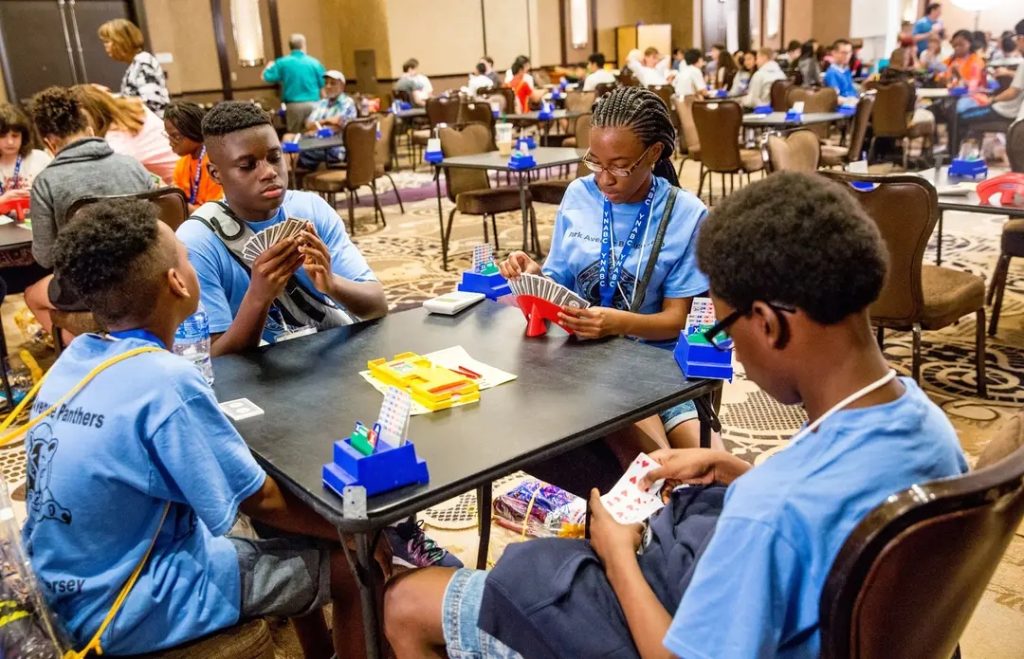
Bridge Esports games are exploding! After the success of the Olympic Virtual Series in 2021, the International Olympic Committee (IOC) launched the “ Olympic Esports Week” competition in 2023 , which took place in Singapore from June 22 to 25. On this occasion, the bridge was highlighted through live demonstrations in its dedicated stand ! Bridge under the guidence of World Bridge Federation was among the disciplines selected to compete at the Olympic Esports Week (“OEW”) in Singapore, June 19-25, organized by the International Olympic Committee. The WBF, together with the platform providers BBO and Funbridge, had a pavilion at the Free-To-Play Zone (“FTPZ”) the IOC provided for a limited number (10-15) of its recognised “International Federations” during the OEW. It was a great achievement and honour for Bridge to have been selected as one of them, to showcase Bridge progress and activities in the field of electronic sports. It was an important opportunity for all Bridge, players, stakeholders, NBOs as well as the WBF, to showcase Bridge as a modern sport – adopting the latest technology, including Artificial Intelligence.
Comments




